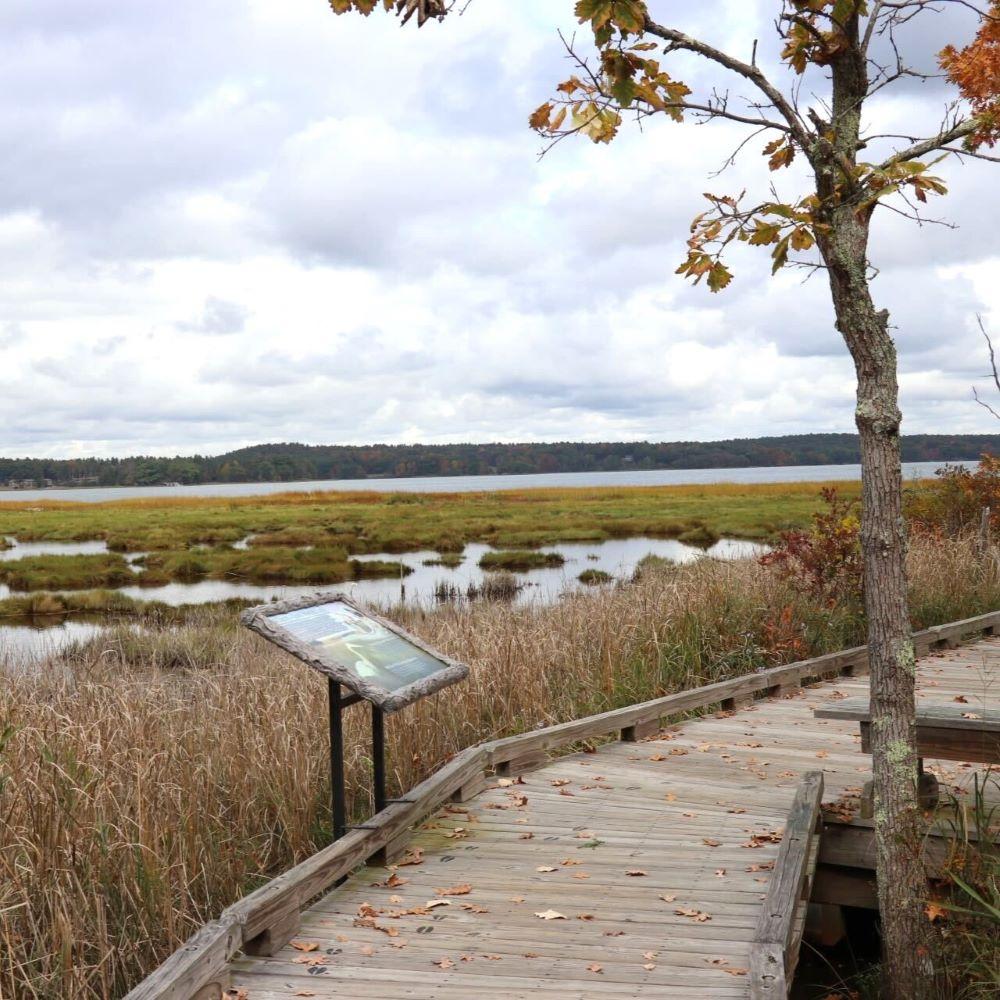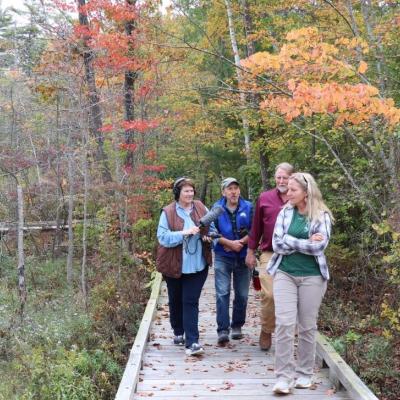- Tags:
- Something Wild,
- Recreation,
- Wildlife

The Great Bay Discovery Center boardwalk. (Photo: Zoey Knox/NHPR)
As we continue our series exploring thoughtfully designed hiking trails that allow people of varying ability to access our state's natural beauty, Something Wild is at the Great Bay National Estuarine Research Reserve in Greenland, N.H.
NH Audubon’s Chris Martin, co-host of Something Wild, was eager to visit this ecosystem. “It's different than the other ones we've seen recently - it goes across a salt marsh.”

Our guide is Kelle Loughlin, director at the Great Bay Discovery Center.
Great Bay is one of the largest estuaries on the Atlantic Coast, covering 6,000 acres. An estuary is a tidal inlet where fresh water from rivers mingles with salt water from the sea.
Several rivers, including the Lamprey, Squamscott, and Winnicut, flow into Great Bay and mix with tidal waters from the Atlantic Ocean.
Often called New Hampshire’s “hidden coast,” Great Bay is one of the most recessed estuaries in the U.S. Saltwater travels 10 to 15 miles through the Piscataqua River before reaching the bay.
Great Bay comprises five major habitats: salt marsh, mudflats, eelgrass, rocky shore and open water. Loughlin says at low tide, there's over 2,000 feet of mudflats
The brackish water makes demands of the plants that grow along the shore. “If you put a geranium in an estuary, it's going to die instantly,” says Loughlin. ”It's going to absorb salt. But the plants that live along the edge of an estuary, like the spartina, cordgrass, have the ability to exude salt. They do a sort of reverse osmosis.”
We start our tour at the Great Bay Discovery Center visitors center. The trail winds through the gardens in a series of switchbacks to the lower elevation and through the forest adjacent to the bay. The trail eventually loops over the salt marsh, thanks to a 1,700-foot boardwalk.
“This is what we call our zigzag trail, which is a wonderful, accessible trail,” says Loughlin. “ And over the last year, we created this sensory garden. And in the spring, all of these grow blue flowers, so you can see what looks to be a sweeping wave of water in blue flowers.”
The trail ends at a large heron sculpture that appears to fly out to the estuary. At the stone wall at the end of the zigzag, fragrant plants are at a level that makes it easy to enjoy the fragrance if you’re in a wheelchair.
Before we enter the woods, we hear wild turkey calls. “That's our [school] children that are practicing turkey calls. They're pretty good at it!” says Loughlin.
As we follow a trail through the woods called the “Trail of the Arrowhead,” Loughlin explains how the Great Bay Discovery Center engages the approximately 5,000 students who visit during the school year.
“We are bringing students along a journey that was traveled by the Abenaki,” she says. “They get to visit a model wigwam, they learn about turkeys, they get to try turkey jerky, they get to try salmon. They learn about the use of decoys. So it's a kind of a journey back in time.”
“I know that this captures the imagination of kids, because it's not just a story that they're hearing,” says Something Wild co-host Dave Anderson of the Forest Society, as we stop at a replica of a smoker for a tidbit of smoked salmon.
“It can really capture kids' imaginations, to look at a fox pelt or a coyote pelt and sit inside of a wigwam. It's see, hear, smell, touch. And now taste - all five senses.”
The boardwalk has viewing platforms for wildlife and bird watching. You might see one of the many creatures that live in the area, such as mink or otter.
The estuary is part of the North Atlantic flyway for migrating birds, and home to wintering bald eagles. “There are migrating warblers and raptors,” says Loughlin. “It is a really incredible place to see all of those birds, and you can do that in a wheelchair.”
Listen as Something Wild explores the Nature Conservancy’s Manchester Cedar Swamp and the NH Audubon All Persons Trail in this series about sustainable trails expanding access to New Hampshire’s great outdoors.
Something Wild is a partnership of the Forest Society, NH Audubon and NHPR.
